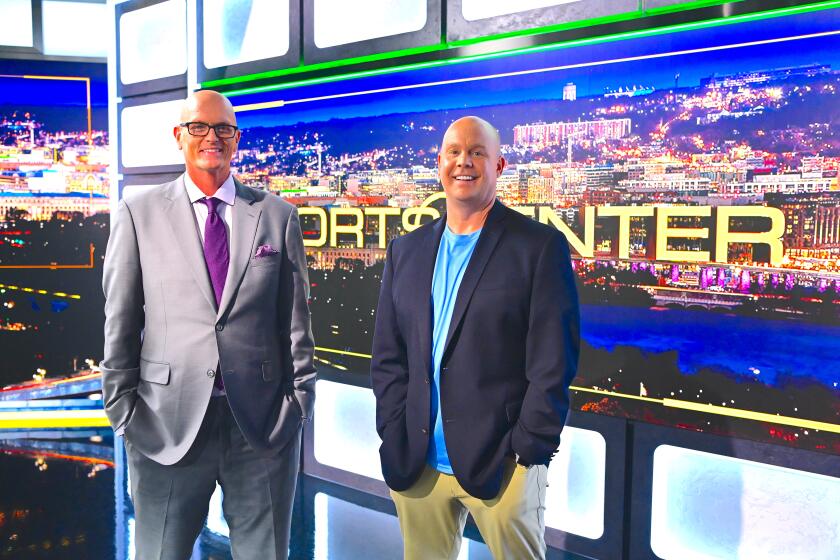La Plaza stumbles as push for national museum gains foothold
Television’s highest-earning actress and a San Francisco art museum chief are two of the key figures in the bid to establish a new museum on the National Mall in Washington, D.C., devoted to the history and culture of American Latinos.
But Eva Longoria, who will rally public support for a bill in Congress to create the museum, and Jonathan Yorba, chairman of the museum-lobbying group that picked her, also played key roles in the creation of a problem-plagued Los Angeles museum and cultural center focused on the contributions of Mexican Americans in Southern California.
From 2004 to 2006, Yorba was the first executive director of La Plaza de Cultura y Artes, trying to lay the groundwork for the downtown museum that finally opened in April and almost immediately ran into extreme financial difficulties.
At La Plaza, Yorba was expected to help ignite a $50-milion fundraising effort, but it never got off the ground. The organization raised just $51,000 in private donations during the two years during which he was in charge; Yorba, meanwhile, earned $210,000 over the two years, according to the nonprofit La Plaza’s federal tax returns.
Longoria, who according to Forbes Magazine earned $13 million acting in “Desperate Housewives” and doing product endorsements during the 12 months ending last May, has served on the financially strapped La Plaza’s board for the past 18 months. The board learned three months after its opening that La Plaza was in financial turmoil. Half its staff was laid off amid assertions by the board that chief executive Miguel Angel Corzo had mismanaged La Plaza’s business affairs. Corzo left after his contract ran out in August.
Yorba is now chairman of Friends of the National Museum of the American Latino, a private, nonprofit group that’s pushing for creation of a museum that, according to current projections, would require the federal government to pay half its $402-million construction cost and about 40% of its $47-million annual operating cost.
The Friends group announced Dec. 8 that Longoria and Emilio Estefan, the Miami-based musician and record producer who was instrumental in launching his wife, Gloria, to pop stardom, “have agreed to take leadership roles” in the campaign to win the needed congressional OK.
Last month, identical bills were introduced in the House and Senate that would create the Latino museum as a new branch of the Smithsonian Institution. The bills, sponsored by nine senators and two House members, among them four Latinos, calls for establishing the museum in the Arts and Industries Building, a vacant, 130-year-old historic structure on the National Mall.
In September 2004, La Plaza, whose prime mover is Los Angeles County Supervisor Gloria Molina, received from the Board of Supervisors what backers of the national Latino museum are seeking from Congress — a green light to create an institution, a commitment of construction money, and authorization to renovate two historic, county-owned buildings from the 1880s.
At the time, Yorba said he was going to “hit the fundraising trail” to help La Plaza reach its goal of raising $50 million in three years. As it turned out, over the next seven years La Plaza managed to raise only about $2.9 million in private donations; government expenditures have totaled $36 million.
The lack of donations has been the primary source of La Plaza’s woes. Private funds are expected to cover its staffing and programming costs; the county provides $1 million annually for maintenance, insurance and utilities.
Now Yorba, whose day job is chief executive of the Mexican Museum in San Francisco, is the volunteer chairman of Friends of the National Museum of the American Latino, making him an important player in the lobbying effort to pass the legislation that would create it. The position does not mean he would help run the museum if it is approved. In addition to lobbying for the museum bill, the Friends group is trying to raise money for the project. However, a preliminary federal report on the museum says that an official fundraising campaign — projected to take 10 years — would not begin until Congress authorizes its creation.
Asked to make Yorba and Longoria available for interviews about their roles at La Plaza and in the effort to create a national Latino museum, the Friends of the National Museum of the American Latino responded with a written statement: “We have no insight regarding the past or present issues surrounding … La Plaza … and cannot, therefore, comment.” Yorba did not respond to interview requests left with his assistant at the Mexican Museum.
The Mexican Museum is a tenant at San Francisco’s Fort Mason Center, but Yorba, who became its chief executive a year ago after four years as arts and culture manager for Riverside, is shepherding a construction project that like La Plaza will be largely publicly funded.
The San Francisco Chronicle reported that the city’s redevelopment agency has committed $10.5 million toward the estimated $14-million cost of reestablishing the museum within a planned private residential development. In October, California issued an additional $800,000 grant from its California Cultural and Historical Endowment to cover most of the new museum’s design costs.
The bill to create a national Latino museum was spurred by the report last May of a special study commission of presidential and congressional appointees, which urged moving ahead with the museum and recommended the Arts and Industries Building as a preferred site.
The study commission estimated $402 million for construction and suggested that the federal government bear half the cost. It also envisioned the federal government paying about 40% of the projected annual operating cost of $47 million, in keeping with the federal share at other Smithsonian museums.
Since September, La Plaza has tried to move forward from what Molina has described as its “unbelievably painful birth.” It has begun offering monthly special events and free-admission days, including an October Cantinflas film festival and a tribute to the Chicano art movement on Saturday and Sunday, in conjunction with the region-wide Pacific Standard Time project on Los Angeles art from 1945 to 1980.
La Plaza board member Miguel Santana, budget officer for Los Angeles, said recently that since reports of La Plaza’s financial difficulties emerged about two months ago, “the response of the community has been tremendous,” including upticks in donations and attendance. Total attendance for April through December is projected at 45,000, Santana said, including about 3,000 free admissions for school groups.
“The board has come together and is committed for the long haul,” Santana said, adding that the modest $1.8-million budget for the current fiscal year, including the $1 million in county support, is “a reasonable budget and goal” while the organization works on building its board and increasing its fundraising capacity. Among the goals in the coming year, he said, is landing a sponsorship or grant that would enable La Plaza to waive its $9 admission fee.
As for the effort to create a national Latino museum, Santana said, “we see that as being very much consistent and supportive of what we’re doing.” Rather than competing with La Plaza for donors, he thinks the push to build the national museum could generate greater overall interest in giving to organizations devoted to Latino history and culture.
More to Read
The biggest entertainment stories
Get our big stories about Hollywood, film, television, music, arts, culture and more right in your inbox as soon as they publish.
You may occasionally receive promotional content from the Los Angeles Times.











